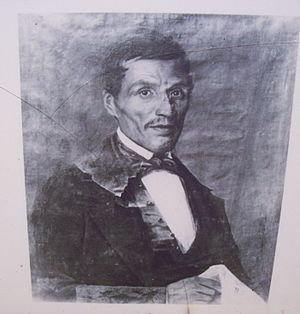John Wannuaucon Quinney facts for kids

John Wannuaucon Quinney (born 1797 – died July 21, 1855) was an important leader and diplomat of the Mahican people, also known as the Stockbridge tribe. He was sometimes called "The Dish."
Contents
Early Life and Background
John Quinney was born in the Hudson River Valley area of Connecticut. During his life, he lived in several different places, including Norwich, Connecticut, Stockbridge, Massachusetts, and Oneida, Wisconsin. He worked hard to protect the rights of Native American people. He also believed in finding ways for his tribe to adapt to modern times, while still keeping their traditions.
Working for His People
John Quinney was a key figure in helping his tribe deal with the United States government. He worked to secure land and rights for the Mahican people.
Seeking New Lands
In 1822, John Quinney was one of three people chosen to travel to Green Bay, Wisconsin. Their mission was to buy land for members of New York tribes who wanted to move west into Wisconsin. They bought land from the Menominee people. Tribe members moved west in groups each year, and by 1829, everyone had relocated.
Land Disputes and Treaties
Later, in 1827, the Menominee tribe met with U.S. government officials to settle a disagreement about their land borders. The Menominee ended up selling some of their land to the government. This included land along the Fox River that they had already sold to the Mahican people.
John Quinney stepped up to represent the Mahican tribe in 1828 and 1830. He tried to get official ownership of the disputed land. However, the Menominee tribe said they no longer recognized their earlier sale to the New York tribes.
Because of this, the Stockbridge and Munsee tribes decided to negotiate a new treaty with the United States government in 1831. These talks finished in 1832. The tribes successfully secured two areas of land on the east shore of Lake Winnebago. These areas became the towns of Stockbridge and Brothertown.
Changing Tribal Government
In 1837, John Quinney wrote a new constitution for his tribe. More than half of the tribe approved it. This new constitution changed their traditional way of governing, which had been based on family heredity. Some tribe members did not want to give up their old ways, which caused some disagreements within the tribe.
To solve this, they decided to sell half of their land. This allowed some members to move even farther west. For the next five years, Quinney continued to represent his tribe. He worked with the United States Congress to try and get compensation for the losses his tribe faced from being moved so many times.
Citizenship and Later Life
In 1843, the United States Congress made the tribe members United States citizens. However, some members wanted to return to their tribal status. John Quinney represented these members. He helped negotiate a treaty in 1848 that said the tribe could move west again if suitable land was found.
By 1852, this new land had not been found. John Quinney was getting old and sick. He asked Congress to give him the official ownership of his home in Stockbridge, Wisconsin. His request was approved in 1854, and he became a United States citizen.
John Quinney passed away in Stockbridge, Wisconsin on July 21, 1855. The next year, a new treaty was made with the Menominee tribe to buy land. This led to the creation of the Stockbridge–Munsee Community, which is still active today.
A New Term: "Native American"
In 1852, John Quinney sent a special message to the United States Congress. In this message, he called himself "a true Native American." Some experts believe this was the first time this term was used to describe the original people of the Americas.
Fourth of July Speech in 1854
In 1854, John Quinney gave an important speech in Reidsville, New York, on the Fourth of July. In his speech, he shared his thoughts about the changes he had seen in his lifetime.
He spoke about how the wealth and power of the European settlers had grown. At the same time, he saw his own tribe's numbers and influence decline. He felt that the end of his tribe's traditional way of life was unavoidable.
Quinney also mentioned a prophet who had predicted the arrival of the "palefaces" (white people). He said that at first, Native Americans felt surprised and even sorry for these white men. Later, they admired their intelligence.
However, he also spoke about how promises made by white men were often broken, sometimes on purpose. He claimed that diseases like Smallpox and Measles were brought by white men, which greatly reduced the Native American population. He also said that white men encouraged fights between different tribes.
He explained that if a tribe left a piece of land for hunting, that land would often be called "abandoned" and then taken away. John Quinney ended his powerful speech by asking for justice for himself and his tribe. He finished by saying, "may the Great Spirit enable me to die in hope."


